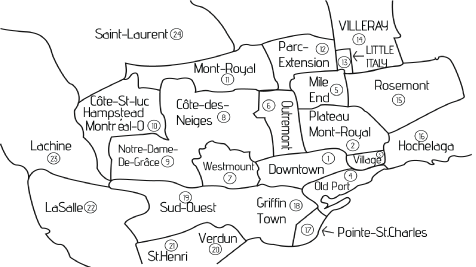When it comes to finding your new—albeit temporary—home, there are dozens of factors to consider. Location is crucial—how long is the walk to campus? Is there a nearby metro station? Access to grocery stores, or attractions and diversions? Do you want something more upscale, or do you want to keep your costs low? Beyond the insular McGill bubble, there are enough housing options to meet any unique preferences you might have.
Milton-Parc: The upside of living in the Milton-Parc area is that it’s as close to McGill as you can get. The downside is that rent is high and with campus a stone’s throw away, anything further than a 10 minute walk seems disproportionately far. In addition, many apartments in this area have undergone significant wear-and-tear due to their transient tenants.
West of campus: If you want the proximity to campus but slightly nicer accommodations, the apartments just west of campus are equally close as the Milton-Parc area and a bit less grungy. However, rent is on the high side and there’s a notable lack of grocery stores nearby.
Quartier Concordia: A student-heavy area with mainly older low-rise apartment buildings. The cost of rent is a bit lower since there is less competition than in the housing area around McGill. The neighbourhood was part of a redevelopment project in the early part of the millenium that aimed to create a green urban environment that would improve the use of public space, student life, and transportation.
Plateau: A predominantly francophone area, it takes about 25 minutes to get to campus, but the area is brimming with advantages like Parc Lafontaine, chic stores, and trendy restaurants. As you move further to the east, the rent becomes cheaper.
St. Henri and Little Burgundy: More students and young professionals have been moving into the area, which has pushed up the price of rent, although they still remain relatively low. By metro, the trip to campus is only 15 minutes. If you’re into fresh produce, Atwater market is also in the area.
The Village: The village is a vibrant neighborhood, especially in the summer, when the numerous restaurants in the area have outdoor terraces and Saint-Catherine Street is closed off to cars. The 15-20 minute public transit ride to campus is convenient because of the three metro stations in the area. Plus, the rent is fairly inexpensive.
Côtes-des-Neiges: The relatively affordable area is one of the most ethnically diverse in the city. The cultural heterogeneity is reflected in the mixed-bag of cuisine offered by neighbourhood restaurants. Most housing in Côtes-des-Neiges are low-rise buildings, and the area is much closer to University of Montreal than McGill campus.
Mile End: A neighbourhood for people who love art and bagels, the Mile End is a hip area, located 15-20 minutes by public transit away from campus. Increasing popularity has put upward pressure on the price of duplex and triplex housing in this area.
Tips and tricks:
Apartment sizing: Advertisements list the number of rooms—not only bedrooms—in the apartment. Bathrooms are written as a half a room. For example, a two-bedroom apartment with a living room, kitchen, and bathroom would be listed as 4 ½ rooms.
Sublet: If a tenant is going to be absent from the apartment for a stretch of time like during the summer, they can rent the apartment out to someone else. The sub-tenant and the tenant work out the arrangements between themselves, and the landlord is simply notified.
Lease transfer: The document that assigns the lease to a new tenant and releases the previous tenant of all rights and responsibility of the apartment before the term of the original lease is over.
Finder’s fee: A fee—sometimes thousands of dollars—that current tenants charge incoming tenants when executing a lease transfer, often under the guise of a payment for furniture. Due to the fact that a landlord is not legally allowed to rent the apartment while another group is still renting it, the landlord is unable to intervene. Although a common practice, it is illegal and an abuse of Quebec tenants’ rights.








